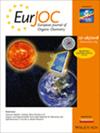推拉式茚衍生物的全色荧光溶色性
IF 2.5
3区 化学
Q2 CHEMISTRY, ORGANIC
引用次数: 0
摘要
用两个碳桥式低聚(苯乙烯)(COPV)衍生物Ph2N‐COPV1(Bu)‐COCH3和[Ph2N‐COPV1(Bu)]2CO在推拉系统中证明了全色荧光溶剂化,其中供体和受体分别是二苯胺和羰基。在非极性环己烷中,分子表现出具有局部激发特征的蓝色光致发光(λPL = 443和464 nm),而在极性溶剂中,则出现电荷转移特征。在甲醇中观察到红色发射(λPL = 602和572 nm)。Ph2N‐COPV1(Bu)‐COCH3和[Ph2N‐COPV1(Bu)]2CO的环己烷和甲醇的最大发光差分别为0.74和0.59 eV,比之前报道的推挽体系的最大发光差大。Ph2N‐COPV1(Bu)‐COCH3在非质子溶剂中的光致发光量子产率均在0.90以上,而在质子溶剂中则有所下降。这些分子也显示出很高的消光系数,高达2.8 x 104和6.4 x 104 M(⁻¹cm)。这些数据证明了使用结构刚性平面COPV框架的有效性。此外,在四氢呋喃-水混合溶剂中,[Ph2N‐COPV1(Bu)]2CO对含水量有显著的响应,这突出了其在传感应用中的潜力。本文章由计算机程序翻译,如有差异,请以英文原文为准。

Full‐Color Fluorescence Solvatochromism of Push‐Pull Type Indenoindene Derivatives
Full‐color fluorescence solvatochromism was demonstrated using two carbon‐bridged oligo(phenylenevinylene) (COPV) derivatives Ph2N‐COPV1(Bu)‐COCH3 and [Ph2N‐COPV1(Bu)]2CO with a push–pull system, where the donor and acceptor moieties are diphenylamino and a carbonyl group, respectively. In non‐polar cyclohexane, the molecules exhibited blue photoluminescence (λPL=443 and 464 nm) with a locally excited character, while in polar solvents, a charge‐transfer character emerged. In methanol, red emission was observed (λPL=602 and 572 nm). The difference in luminescence maxima between cyclohexane and methanol corresponds to 0.74 and 0.59 eV for Ph2N‐COPV1(Bu)‐COCH3 and [Ph2N‐COPV1(Bu)]2CO, respectively, which are larger than those of previously reported push–pull systems. The photoluminescence quantum yields of Ph2N‐COPV1(Bu)‐COCH3 in aprotic solvents were 0.90 and higher regardless of solvent polarity, while they decreased in protic solvents. The molecules also display high extinction coefficients of up to 2.8x104 and 6.4x104 M−1 cm−1. These data demonstrate the effectiveness of the use of structurally rigid planar COPV framework. Furthermore, [Ph2N‐COPV1(Bu)]2CO showed significant responses to water content in tetrahydrofuran‐water mixed solvents, which highlights its potential for sensing applications.
求助全文
通过发布文献求助,成功后即可免费获取论文全文。
去求助
来源期刊
CiteScore
5.40
自引率
3.60%
发文量
752
审稿时长
1 months
期刊介绍:
The European Journal of Organic Chemistry (2019 ISI Impact Factor 2.889) publishes Full Papers, Communications, and Minireviews from the entire spectrum of synthetic organic, bioorganic and physical-organic chemistry. It is published on behalf of Chemistry Europe, an association of 16 European chemical societies.
The following journals have been merged to form two leading journals, the European Journal of Organic Chemistry and the European Journal of Inorganic Chemistry:
Liebigs Annalen
Bulletin des Sociétés Chimiques Belges
Bulletin de la Société Chimique de France
Gazzetta Chimica Italiana
Recueil des Travaux Chimiques des Pays-Bas
Anales de Química
Chimika Chronika
Revista Portuguesa de Química
ACH—Models in Chemistry
Polish Journal of Chemistry.

 求助内容:
求助内容: 应助结果提醒方式:
应助结果提醒方式:


